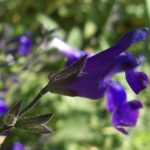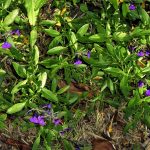Salvia coahuilensis: is a low groundcover to 20cm H for sunny positions with long green leaves and dark purple flowers all the year.

Salvia coahuilensis: is a great low groundcover for a sunny area.
Flowers: are a blue purple with the hood being a slightly darker purple than the rest of the flower. There is a white beeline area around the throat to guide the bees and other pollinating insects further into the flower. The middle lobe is wide and slightly split.
Flowers appear for most of the year on green stems usually held above the foliage to attract passing insects, but can appear lax as they age, with flowers being found among the foliage.
Calyces: are green, slightly hairy, very ribbed with pointed lobes.
Flowers appear either in pairs or small whorls of 4flowers. Green bracts fall off as each group of flowers open up.
Leaves: are slender, lineal, entire edges with only the midrib showing, grass green with a shiny surface. All the stems are green being sparsely clothed with leaves.
Salvia coahuilensis: is often confused with Salvia ‘Navajo Purple’, but all stems are green, flowers are dark blue purple, NOT violet and the leaves are wider and larger than S. ‘Navajo Purple’.
A lovely ground cover for the front of the bed or a pocket in a rock wall for a sunny position. As this a neat growing plant, grow as an edge along a path or in an informal border.
Plant in front of other small vibrant coloured shrubs and perennial to show off this lovely groundcover.
This is a tough and hardy plant for the hot dry summer months, tolerating winter cold and light frosts.
Although S. coahuilensis will flower for most of the year, at the end of autumn, when the plant might be looking a bit tatty, now is the time to clean out. Cut off any old flowering stem, any dead or straggly stems and clean out old dead leaves.
Feed and mulch to keep the root area cool during the summer.
Propagation: is usually by tip cuttings or by rooted stems or layered pieces. Very bee and insect friendly.


